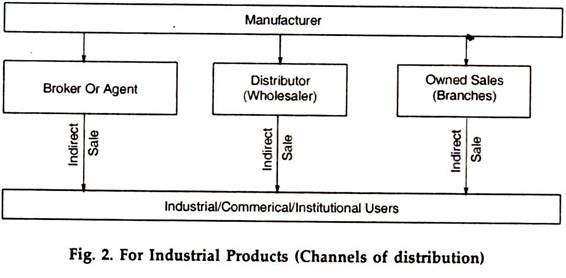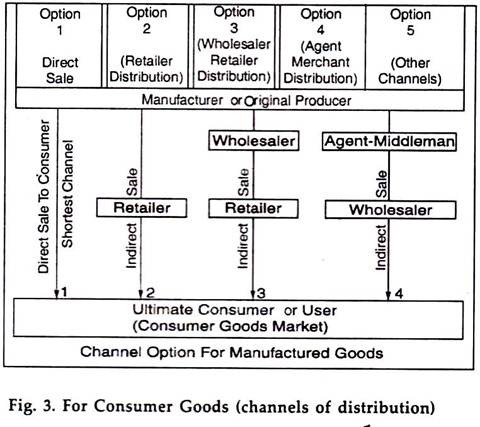This article throws light upon the five most common routes used for bringing products in the market. The routes are: 1. Manufacturer→ Consumer→ Channel 2. Manufacturer→ Retailer→ Ultimate Consumer 3. Manufacture→ Wholesaler→ Retailer→ Consumer 4. Manufacturer→ Agent→ Wholesaler→ Retailer→ Consumer 5. Manufacturer→ Wholesaler→ Consumer or User.
Route # 1. Manufacturer→ Consumer→ Channel:
(Direct Sale) There are three alternatives in direct sale to consumers:
(a) Sale through-advertising and direct methods (mail order selling),
(b) Sale through travelling sales force (house to house canvassing),
(c) Sale through retail shops of manufacturer e.g., mills cloths hops, Bata Shoe Company Shops.
This is a shortest channel a product can follow to the market. Industrial goods may be sold directly to industrial buyers. Usually we have numerous and scattered consumers who buy in very small quantities. Hence, this channels is not popular for a wider market.
Route # 2. Manufacturer→ Retailer→ Ultimate Consumer:
This channel option is preferable when buyers are large retailers, e.g., a department store, discount house, chain stores, super-market, big mail order house or co-operative stores. The wholesaler can be bypassed in this trade route.
It is also suitable when products are perishable and speed in distribution is essential. Automobiles, appliances, men’s and women’s clothing, shoes are sold directly to retailers. However, the manufacturer has to perform functions of a wholesaler such as storage, financing of inventories and transport.
Route # 3. Manufacture→ Wholesaler→ Retailer→ Consumer:
This is a normal, regular and popular channel option used in groceries, drugs, drug goods, etc.
It is suitable for a producer under the given conditions:
(a) He has a narrow product line,
(b) He has limited finance,
(c) Wholesalers are specialised and can provide strong promotional support,
(d) Products are durable and not subject to physical deterioration or fashion changes.
The best means of transport and communications, growth of big retailers, computer handling of small innumerable orders of retailers, advances in automatic data processing, information explosion, etc., may reduce the need and importance of wholesalers in future.
Route # 4. Manufacturer→ Agent→ Wholesaler→ Retailer→ Consumer:
In this channel the producer uses the service of an agent middleman such as a sales agent, for the initial dispersion of goods. The agent in turn may distribute to wholesalers, who in turn sell to retailers. Many textile mills have sales agents for distribution.
We may have a large national distributor such as Voltas, acting as sole sales agent for many manufacturers. Agent middlemen generally operate at the wholesale level. They are common in agricultural marketing. In marketing manufactured goods, agent middlemen are used by manufacturers to make themselves free from marketing tasks. An agent middleman sells on commission basis directly to wholesaler or large retailer.
Route # 5. Manufacturer→ Wholesaler→ Consumer or User:
Wholesaler may by-pass retailer when there are large institutional buyers, e.g., industrial buyers, government, consumer co-operatives, hospitals, educational institutions, business houses, etc.


